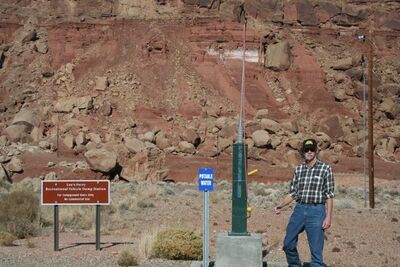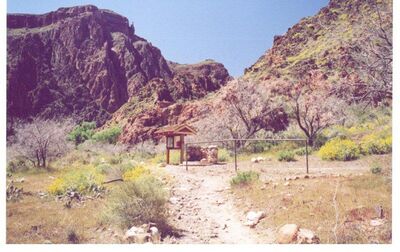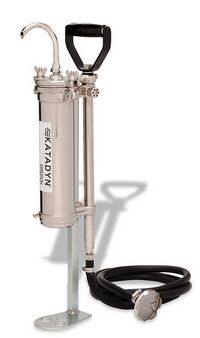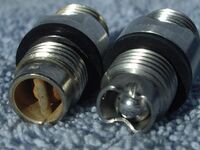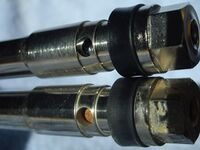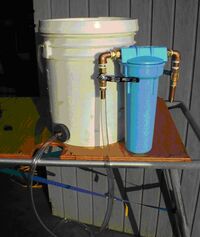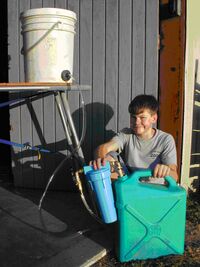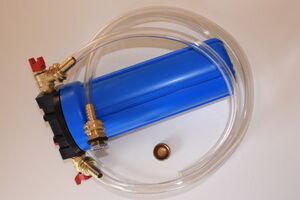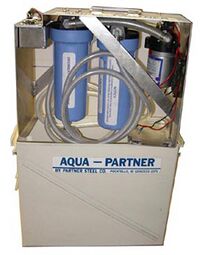Drinking Water Management
Before we get into the fine art of water filtration, let's look at a couple of places to get treated water on your river trip:
Drinking Water at Lee's Ferry
There is year-round potable water available at the Lee's Ferry put-in. After the last frost in March or early April, the outside water spigot at Lee's Ferry is turned on. This spigot is located on the west side of the restroom. The restroom is located on the north side of the Lee's Ferry parking lot. Filling up 5 or 6 gallon water jugs is allowed here. This water spigot is turned off in November, when freezing temperatures arrive at the Ferry.
In the winter, there is a service door on the south side of the bathroom between the Men's and Women's entrances. Inside this door there is a water tap for filling water jugs.
It is possible that the water system may be closed for repairs when you are there. Year-round water is also available at the RV station across the street from the large water tower by the rangers houses.
Drinking Water at Phantom Ranch
The Phantom Ranch boaters bulletin board and water tap is just 100 yards west of the boat beach (River Mile 88.1 right, Guide to the Colorado River in Grand Canyon, Martin/Whitis Third edition). It's an easy downhill carry of full jugs back to the boats from this water tap. This is a year round tap, but may be turned off if there's a break in the trans-canyon water line. This occurs roughly 10 days out of 365, and is on a frequency that is anyone's guess.
Ok, so much for the treated water sources. Let's now look at the science behind treating water, and then look at a couple of ways to do it.
Drinking Water Management
Rafting the Colorado River in Grand Canyon National Park is a multi week journey. Your team will need to provide all your drinking water. During the summer, it is possible for each person in your team to drink over a half gallon of water a day, so having enough water for your trip to cook with and drink is important.
Why Do You Need to Treat Your Water?
Virtually all natural water sources contain microbes of one sort or another. Most of these are harmless to humans, but there are many that can cause anything from a little discomfort to a 24-hour bout of “Montezuma’s Revenge” to a chronic condition like giardiasis.
Everyone has a different tolerance to drinking untreated water depending on their immune system and the dose of microbes they ingest. In many cases, folks may go for years and never have a problem drinking from clear mountain streams, but they run a risk every time. It’s like wearing seat belts. We never expect to be in a traffic accident, but we recognize the risk and buckle up. We should do no less with the water we drink on river trips.
What Water is Safe to Treat?
Water is most “pure” when it first falls from the sky, but even then it is not pure. By the time it hits the ground, it will contain dissolved gasses, particulate matter, and soluble atmospheric pollutants. As it runs over the ground, it picks up additional suspended and dissolved solids. Suspended solids include microbial contaminants (those are the bugs that can make us sick).
Water treatment is primarily designed to remove microbial contaminants, not chemical pollutants. In order to treat water, you need to start with a water supply that is not contaminated with harmful levels of chemical contaminants. Waters to avoid include rivers polluted with runoff from industrial areas, cities, feed lots, and agricultural lands with heavy use of agricultural chemicals. Fortunately, the Colorado River in Grand Canyon has relatively little pollution. This can change when a heavy rainstorm at Page Arizona washes out the golf course pesticides and/or overtops the wastewater treatment facility there, but this is a rare occurrence.
While generalization can be hazardous, avoid water that is collected from stagnant pools, has an odor or oily sheen, or is clear but heavily colored (typically grey or brown). Waters with heavy sediment can be treated if it is mineral sediment as you may below the Paria and Little Colorado Rivers in Grand Canyon.
Water Treatment Made Simple
Basic water treatment involves two processes: 1) physical removal of the majority of suspended solids, which includes microbes, and 2) disinfection of the water to inactivate the bugs that get past step 1 and prevent re-contamination. We say inactivate instead of kill, because we don’t kill all of the microbes. Some are just messed up so they can’t reproduce, and that’s just as good.
There are two basic ways to remove suspended solids: sedimentation (with or without a coagulant like alum to speed and improve the process) and filtration. Sedimentation is always used with filtration, but the reverse isn’t always true. Settling water before filtration can increase the overall treatment efficiency by 90% or more, even in “clear” waters.
Disinfection can be accomplished in a number of ways, most commonly by using a filter element impregnated with silver iodide, by using iodine tablets or drops, with a UV light source, or by using chlorine bleach (AKA sodium hypoclorite solution, the same chemical used by many public water systems instead of chlorine gas).
Filters typically cannot remove particles in the size range of viruses, hence the need for disinfection (UV or Clorox).
Disinfection alone (UV or Clorox) is not always effective against some cysts like cryptosporidium, hence the need for filtering.
Adequate water treatment requires filtration and disinfection!
About Clorox bleach
Even a sealed bottle of bleach will degrade over time, and degradation is accelerated with increasing temperature. Don't use last year's bleach! Buy a new bottle each season, or more often if you do a lot of boating in hot weather. Also, make sure you get unscented bleach or your water will taste quite nasty.
There are a number of ways to purify drinking water on your trip. Here are a few suggested methods:
Water Purification Systems
Type One: Filtration With Clorox
A number of river trips will rent, borrow, or buy a Katadyn Expedition Filter
These filters are great for large expedition groups. The Katadyn will pump up to 1 gallon per minute, assuming the water to be pumped has been settled. The Katadyn filter is housed in a strong nickel plated steel housing, and is built for durability. It's a great large volume pump, but has a delicate filter that does not like to be dropped. The filter is cleanable in the field, and can be cleaned "up to 300 times yielding up to 26,000 gallons before having to be replaced". These filters are expensive, costing around $800. They are fairly durable, though Denis Stratford noted the following on 10-17-07:
My near new Katadyn Expedition Water Filter - less than 9 mos. old - began to lose efficiency, even though the filter element was clean. I took it apart and found two check valves rusted. This allowed water that was sucked in thru the hose to simply push back out instead of being forced thru the filter element. Katadyn North America Customer Service was not surprised to hear this and told me "... There was a bad batch (of valves) that used the wrong material..."
"They sent me replacement valves at no cost. Offending Part Numbers are: 22303 Check Valve at Pickup Hose, and 22316 Pump Handle (check valve is integral with the handle). I'd suggest that any owner of a Katadyn Expedition Water Filter inspect their check valves and request replacements if they show signs of rust.
Katadyn filters do not kill or remove viruses. Katadyn users are strongly recommended to add Clorox to the filtered water in the amount of 2 drops per gallon of water. Use plastic droppers from any pharmacy. Use fresh Clorox, as bottles from 'last year' are likely to contain little of the fugitive chlorine. If in doubt, give it the sniff test, compared with a new bottle.
Another water filtration method, called the Canister Filtration method, was introduced to river runners by Duwain Whitis. This system uses a standard "whole house water filter" system, and "assembly" is required.
This system uses a 10" long, 1 micron paper filter (Brands are Pentek / Culligan / Ametek ECP1-10 Water Filter). The filter is a pleated paper filter. The surface area of the filter is very large, so the flow can be very high.
The paper filter is housed in a hard plastic filter housing (Example Brand is Culligan HF-360). The housing has a 3/4" inlet and outlet with a reducing bushing to 3/8" with a ball valve on both the inlet and outlet ends. A short piece of pipe on the outlet ball valve end allows the unit to perch on a standard 5 gallon water jug. A 1/2" barb fitting is attached to the inlet ball valve. six feet of 1/2" vinyl tubing connects the filter to a 5 gallon bucket with a barb fitting secured to the side of the bucket. The bucket is fitted near the bottom with a standard bulkhead fitting turned inside out. A 1/2" brass hose barb is epoxied into the bulkhead fitting. If the 5 gallon bucket is fitted with a screw-on lid, the entire filter kit stores in the bucket.
Here is a Canister Filtration system in use:
There are Two steps to using this system:
Step one:
When you arrive in camp, collect several 5-gallon buckets of river water. Five buckets should be adequate for 16 persons on a summer trip. Each bucket will produce about 3-4 gallons of filtered water after allowing for spillage and the water remaining after decanting. Add 1 teaspoon alum and 1/4 to 1/2 teaspoon of bleach per 5-gallon bucket, stir it up, and let it stand overnight.
This gives you plenty of contact time for the alum to work on pulling out the suspended sediment while the chlorine disinfects the water. This also allows the chlorine to dissipate to the atmosphere somewhat. You should have one or two 5-gallon water jugs of pre-filtered water available for use in the evening. DO NOT OVER-CHLORINATE!
The water should be pre-settled if it is even slightly turbid (cloudy) using, as stated above, 1 teaspoon of alum per 5 gallon bucket of water with the bleach. Stir it vigorously to dissolve the alum and let it stand overnight to settle. You will be very surprised how much material will settle out of water that looks reasonably clear. This is a very important step that many folks overlook. If you pre-settle the water, you will typically remove at least 90% of the microbes and suspended solids in the water. Pre-settling the water will extend the life of the filter elements. Water should be clear before filtering. Heavy sediment will plug the filter element quickly and render it ineffective.
Step two:
First thing the following morning, set up the water filter reservoir bucket and filter (see photo below). Set the bucket on the end of a kitchen table or a tall rock, or hang it from a tree.
CAREFULLY decant the settled water from the buckets filled the prior evening into the filter reservoir, making sure to fill the hose and expel the air. It’s best to disconnect the hose from the filter housing and maneuver it to allow the air to escape from the end while the hose fills with water. Air pockets can cause the flow to slow or to stop.
Once the hose and filter are filled, use the valve on the filter to start and stop the flow. The filter housing must be lower than the bucket – the lower it is, the more flow you’ll get. Occasionally check the reservoir bucket to make sure it stays filled as you use water. Water can be used directly from the filter or put into containers for later use.
To see a gravity water filter system for sale, check out the Vital Water Products web site. This is a photo of the Virtual Water gravity filter.
Care of your Canister Filter
The filter housing, hose and accessories should be stored in the bucket between uses. Rinse all dirt and sediment out of the hose and off the housing. You should drain the filter housing and spread everything out to dry before storing it after a trip. It is not necessary to drain the housing while on the river, simply close the valves.
Filter elements should be changed whenever decreased flow is noticed but at least once annually. Unscrew the top of the housing, remove the old element, and rinse the housing before reassembling it with a new element. Do not open the filter housing except to change the filter element. Once the element is removed, it must be replaced. Never attempt to clean or reuse an element – throw it away and buy a replacement. Replacement elements must be rated for 1-micron nominal to be effective.
Type Two: Filtration UV
Tired of that yucky chlorine taste when your water boss puts too much Clorox into your water system? Ultra Violet water systems may be your answer. These units are not cheap, and cost about the same as a Katadyn unit. They use a filter like the filtration systems above, but use Ultra Violet light to kill viruses instead of Clorox.
The UV system passes filtered water past a UV light source. This system requires an electric power source, typically a rechargeable battery with a solar panel for recharging. As a battery is required, these systems typically include an electric pump, so you don't have to manually pump or set up a gravity feed.
The UV system with it's paper canister filter, just like the Katadyn and Canister Filtration systems above, needs settled water to operate best. There are drawbacks to the UV filtration system. They require electricity to run the pump and light the UV bulb. Also, if the UV bulb burns out or is not receiving an electrical current, you typically have no way of knowing that the UV system is not operational.
Miscellaneous
You are going to need a place to store your treated water. Most folks use 5 or 6 gallon Water Jugs. These come in many shapes and sizes.
It's real important to mind the caps on these jugs, as they are easy to misplace.
Some folks like to only boat with one jug, while others will take two. Water weighs eight pounds a gallon, so a six gallon water jug will weight 48 pounds. That's a lot of weight. Heavy boats, while harder to row, and harder to flip. You don't want to run out of drinking water, and the more jugs you bring, the less often you have to treat water. These are some trade-offs worth considering.
Another thing to remember is that it's a good idea to have some water jugs rigged where they are easy to get to, especially at lunch.
Legal Stuff... or, You Gotta Be Responsible!
Effective water treatment requires conscientious, consistent use of the treatment system being employed. No water treatment system will produce water that is 100% safe for all persons in all situations. Water purification systems are designed to provide a level of treatment that can reasonably be expected to provide protection for most of the healthy, adult population.
Persons with immune deficiencies, elderly persons, and persons with infants should consult their physicians regarding suitable drinking water before using any in-field water purification system. Failure to follow treatment protocol can render the treatment process ineffective and could lead to illness or death. In-the-Field water treatment systems are intended for temporary use in situations where water from a public water system is not available. Of course, use treated water from a public system when available.
To see a handout put together by Matt Walburger, National Park Service Public Health Program Officer, on food storage and potable water management, check out the two page Public Health River Guide.
There's a list of raw (untreated) water sources throughout the Canyon here.
Click here to return to The Pre-Trip Planning page.
